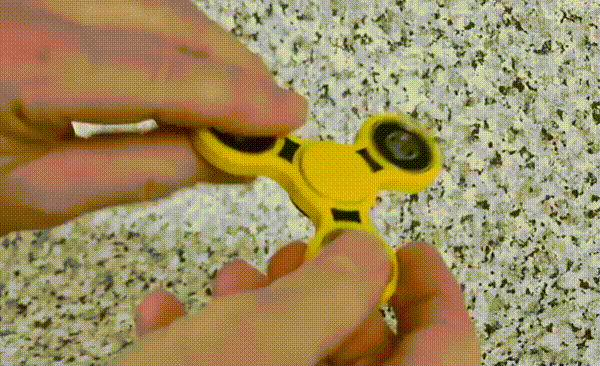Material Spotlight: Fidget Spinners
My upcoming book, The Tinkering Workshop contains twenty spotlights on materials for everyday elements that can be used for playful explorations of art, science and technology. There were plenty of items that we couldn’t fit it into the final version of the book so as a little bit of “bonus content” I wanted to write a few blog posts featuring tinkering materials that didn’t quite make the cut.
For the next material in this series, I wanted to share a couple of possibilities for tinkering with Fidget Spinners. I had never considered tinkering with these popular toys until my collaborator Kenn Munk from A Secret Club brought a few to our tinkering jam session workshop in February. Seeing how participants incorporated these doodads into their projects made me reconsider prototyping with fidget spinners.
Fidget spinners work as a flexible bearing which can rotate smoothly. The traditional design with three lobes with holes in the center offer interesting possibilities for mounting the devices to cardboard or wooden surfaces.
The first way that I used fidget spinners recently was part of a loose parts kaleidoscope station experiment. I cut out a big cardboard circle from a piece of cardboard and added a thin strip around the edge to form a lip all around the outside edge. I used hot glue to attach the center of the fidget spinner to the center of the circle. Then I attached the other side of the fidget spinner to a sturdy square of cardboard that could be taped to the table.
This construction created a space for materials that could be easily spun and viewed under a kaleidoscope. It works as a lazy susan but has the advantage of being very cheap (fidget spinners tend to cost 1-2$ a piece) and completely customizable. These large cardboard spinning discs fit in perfectly to the set of reconfigurable cardboard kaleidoscope parts.
Another use for the fidget spinner that I have been experimenting with are solar panel spinners. I’ve been working informally with Amos Blanton and the “playing with the sun” project to develop new ways to tinker with solar energy. I got inspired by this bike wheel solar spinner that I see everyday on my morning commute. I didn’t know how to get or mount an old bike wheel but I thought that I could make a rough version of the design with solar panel, DC motors with propellors, cardboard and fidget spinners.
For this prototype I made a new system with little rolled up cylinders of cardboard press fit into the three outside holes of the fidget spinner. This allowed the system to be offset from the base and have more room for the propeller to turn. I then attached a large circle of cardboard to the middle of the fidget spinner and added a solar panel in the middle with the motor out on the edge. I needed a weight on the other side to balance the weight.
Once the sun came out, the system worked really well. One of the challenges of making things move with solar power is that it’s not always easy to generate enough energy to make a motor vibrate or a leg scrape against the ground. The combination of motor with propellor and fidget spinner provided very little friction into the system.
After this prototype, I’m imagining ways that we could incorporate the fidget spinner into different types of motion and more complicated designs inspired by the Eames solar-do-nothing machine. These are just two possibilities for using fidget spinners in your tinkering projects. I’m curious what other uses the larger making and tinkering community might imagine for ways this material could be incorporated in tinkering projects. Stay tuned for the next blog posts featuring more “bonus content” material spotlight all in anticipation of The Tinkering Workshop book coming in October.






